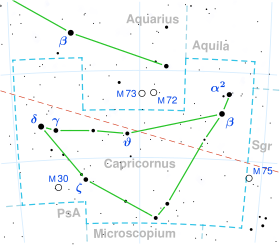Star in the constellation Capricornus
For other stars with this Bayer designation , see ξ Capricorni .
Xi Capricorni , Latinized from ξ Capricorni, is an orange-hued star in the constellation Capricornus . With an apparent visual magnitude of +6.34, it is near the lower limit of brightness for stars that can be seen with the naked eye. Based upon an annual parallax shift of 5.26 mas as seen from Earth, this system is located roughly 620 light-years from the Sun .
It is an evolved K-type giant star with a stellar classification of K0 III. With an age of 3.35 billion years, this star has an estimated 1.55 times the mass of the Sun and is radiating 139 times the Sun's luminosity from its enlarged photosphere at an effective temperature of about 4,439 K.
References
^ Brown, A. G. A. ; et al. (Gaia collaboration) (August 2018). "Gaia Data Release 2: Summary of the contents and survey properties" . Astronomy & Astrophysics 616 . A1. arXiv :1804.09365 . Bibcode :2018A&A...616A...1G . doi :10.1051/0004-6361/201833051 .Gaia DR2 record for this source at VizieR .
^ Corben, P. M.; Stoy, R. H. (1968), "Photoelectric Magnitudes and Colours for Bright Southern Stars", Monthly Notes of the Astronomical Society of Southern Africa , 27 : 11, Bibcode :1968MNSSA..27...11C .
^ Houk, Nancy; Smith-Moore, M. (1978), Michigan catalogue of two-dimensional spectral types for the HD stars , vol. 4, Ann Arbor: Dept. of Astronomy, University of Michigan, Bibcode :1988mcts.book.....H .
Wilson, R. E. (1953), "General Catalogue of Stellar Radial Velocities", Carnegie Institute Washington D.C. Publication , Carnegie Institution for Science , Bibcode :1953GCRV..C......0W , LCCN 54001336 .
Anderson, E.; Francis, Ch. (2012), "XHIP: An extended hipparcos compilation", Astronomy Letters , 38 (5): 331, arXiv :1108.4971 , Bibcode :2012AstL...38..331A , doi :10.1134/S1063773712050015 , S2CID 119257644 .
^ Luck, R. Earle (September 2015), "Abundances in the Local Region. I. G and K Giants", The Astronomical Journal , 150 (3): 23, arXiv :1507.01466 , Bibcode :2015AJ....150...88L , doi :10.1088/0004-6256/150/3/88 , S2CID 118505114 , 88.
"ksi01 Cap" . SIMBAD Centre de données astronomiques de Strasbourg . Retrieved 2017-08-31.
Categories :
Xi Capricorni
Add topic
Text is available under the Creative Commons Attribution-ShareAlike License. Additional terms may apply.
**DISCLAIMER** We are not affiliated with Wikipedia, and Cloudflare.
The information presented on this site is for general informational purposes only and does not constitute medical advice.
You should always have a personal consultation with a healthcare professional before making changes to your diet, medication, or exercise routine.
AI helps with the correspondence in our chat.
We participate in an affiliate program. If you buy something through a link, we may earn a commission 💕
↑
